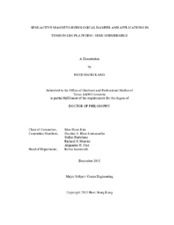| dc.contributor.advisor | Kim, Moo-Hyun | |
| dc.creator | Kang, Hooi Siang | |
| dc.date.accessioned | 2016-05-04T13:22:34Z | |
| dc.date.available | 2017-12-01T06:36:20Z | |
| dc.date.created | 2015-12 | |
| dc.date.issued | 2015-12-14 | |
| dc.date.submitted | December 2015 | |
| dc.identifier.uri | https://hdl.handle.net/1969.1/156488 | |
| dc.description.abstract | A reliable and cost-effective way to protect the hydrocarbon production modules in harsher environments has been crucial to the success of offshore oil and gas projects. Nevertheless, the excessive tension variations in the top-tensioned risers (TTRs) can lead to catastrophic structural integrity issues. Magneto-rheological (MR) damper is a controllable device which can reduce the tension variations. However, the integration and behaviors of MR damper are remained as significant challenge for floating platforms. The main purpose of this research is to develop numerical analysis tool to analyze the specific characteristics of MR damper in offshore structural dynamics and interactively changing the structural behaviors correspond to various external loadings.
The research methodologies were initiated by modeling the hydro-pneumatic tensioner (HPT) of TTR in component-level, which included hydro-pneumatic components and viscous fluid frictional effect. The HPT model was numerically incorporated with MR damper. This numerical tool combined with CHARM3D, a fully-coupled time-domain dynamic analysis program for floating bodies, mooring lines, and risers. The responses of combined numerical model were simulated by coupling with tension leg platform (TLP) and dry-tree semi-submersibles (DTS), respectively, under 100-year extreme condition and 1000-year survival condition of central Gulf of Mexico (GOM). The MR damper was controlled by using semi-active controllers that were developed in fuzzy-logic and skyhook schemes. Mathieu’s stability analysis was utilized to predict TTR’s parametric stability.
The results manifested that total required stroke length in DTS can be reduced by as much as 0.963 meter in the studied case after MR damper was incorporated with semi-active fuzzy logic controller. By providing damped and deformed contact surface, MR damper was able to redistribute the excessive tension in the tensioner cylinders during extreme bottom-out motion. Moreover, the dynamic tension variations of TTR can be suppressed by 94 percent in the case of TLP. In conclusion, these results are beneficial to assure service life span of TTR’s tensioner and moderate the relevant operational expenditure (OPEX). In addition, the reductions of the total required stroke length and tension variations in DTS have enabled the platform designer to be more flexible in the sizing of the DTS and TTR tensioners. | en |
| dc.format.mimetype | application/pdf | |
| dc.language.iso | en | |
| dc.subject | Magneto-Rheological | en |
| dc.subject | Dry-Tree Semisubmersible | en |
| dc.title | Semi-Active Magneto-Rheological Damper and Applications in Tension Leg Platform / Semi-Submersible | en |
| dc.type | Thesis | en |
| thesis.degree.department | Civil Engineering | en |
| thesis.degree.discipline | Ocean Engineering | en |
| thesis.degree.grantor | Texas A & M University | en |
| thesis.degree.name | Doctor of Philosophy | en |
| thesis.degree.level | Doctoral | en |
| dc.contributor.committeeMember | Bhat Aramanadka , Shankar S | |
| dc.contributor.committeeMember | Hurlebaus, Stefan | |
| dc.contributor.committeeMember | Mercier, Richard S | |
| dc.contributor.committeeMember | Orsi, Alejandro H | |
| dc.type.material | text | en |
| dc.date.updated | 2016-05-04T13:22:34Z | |
| local.embargo.terms | 2017-12-01 | |
| local.etdauthor.orcid | 0000-0002-0292-4376 | |


